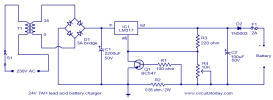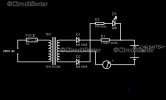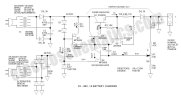Description.
This lead acid battery charger circuit is designed in response to a request from Mr.Devdas .C. His requirement was a circuit to charge two 12V/7AH lead acid batteries in series.Anyway he did not mentioned the no of cells per each 12V battery. The no of cells/battery is also an important parameter and here I designed the circuit assuming each 12V battery containing 6 cells. When two batteries are connected in series, the voltage will add up and the current capacity remains same. So two 12V/7AH batteries connected in series can be considered as a 24V/7AH battery.
The circuit given here is a current limited lead acid battery charger built around the famous variable voltage regulator IC LM 317. The charging current depends on the value of resistor R2 and here it is set to be 700mA. Resistor R3 and POT R4 determines the charging voltage. Transformer T1 steps down the mains voltage and bridge D1 does the job of rectification. C1 is the filter capacitor. Diode D1 prevents the reverse flow of current from the battery when charger is switched OFF or when mains power is not available.
Circuit diagram.

Notes.
This lead acid battery charger circuit is designed in response to a request from Mr.Devdas .C. His requirement was a circuit to charge two 12V/7AH lead acid batteries in series.Anyway he did not mentioned the no of cells per each 12V battery. The no of cells/battery is also an important parameter and here I designed the circuit assuming each 12V battery containing 6 cells. When two batteries are connected in series, the voltage will add up and the current capacity remains same. So two 12V/7AH batteries connected in series can be considered as a 24V/7AH battery.
The circuit given here is a current limited lead acid battery charger built around the famous variable voltage regulator IC LM 317. The charging current depends on the value of resistor R2 and here it is set to be 700mA. Resistor R3 and POT R4 determines the charging voltage. Transformer T1 steps down the mains voltage and bridge D1 does the job of rectification. C1 is the filter capacitor. Diode D1 prevents the reverse flow of current from the battery when charger is switched OFF or when mains power is not available.
Circuit diagram.

Notes.
- Assemble the circuit on a good quality PCB.
- T1 can be a 230V primary, 35V/3A secondary step down transformer.
- If 3A Bridge is not available, make one using four 1N5003 diodes.
- LM317 must be fitted with a heat sink.
- R2 = 0.85 ohm is not a standard value. You can obtain it by combining a 6.2 ohm and 1 ohm resistors in parallel.
- F1 can be a 2A fuse.
- To setup the charging voltage, power ON the charger and hook up a voltmeter across the output terminals and adjust R4 to make the voltmeter read 28V. Now the charger is ready and you can connect the batteries.
- This charger is specifically designed for two 12V/7AH/6 cell lead acid batteries in series OR a 24V/7AH/12 cell lead acid battery.









